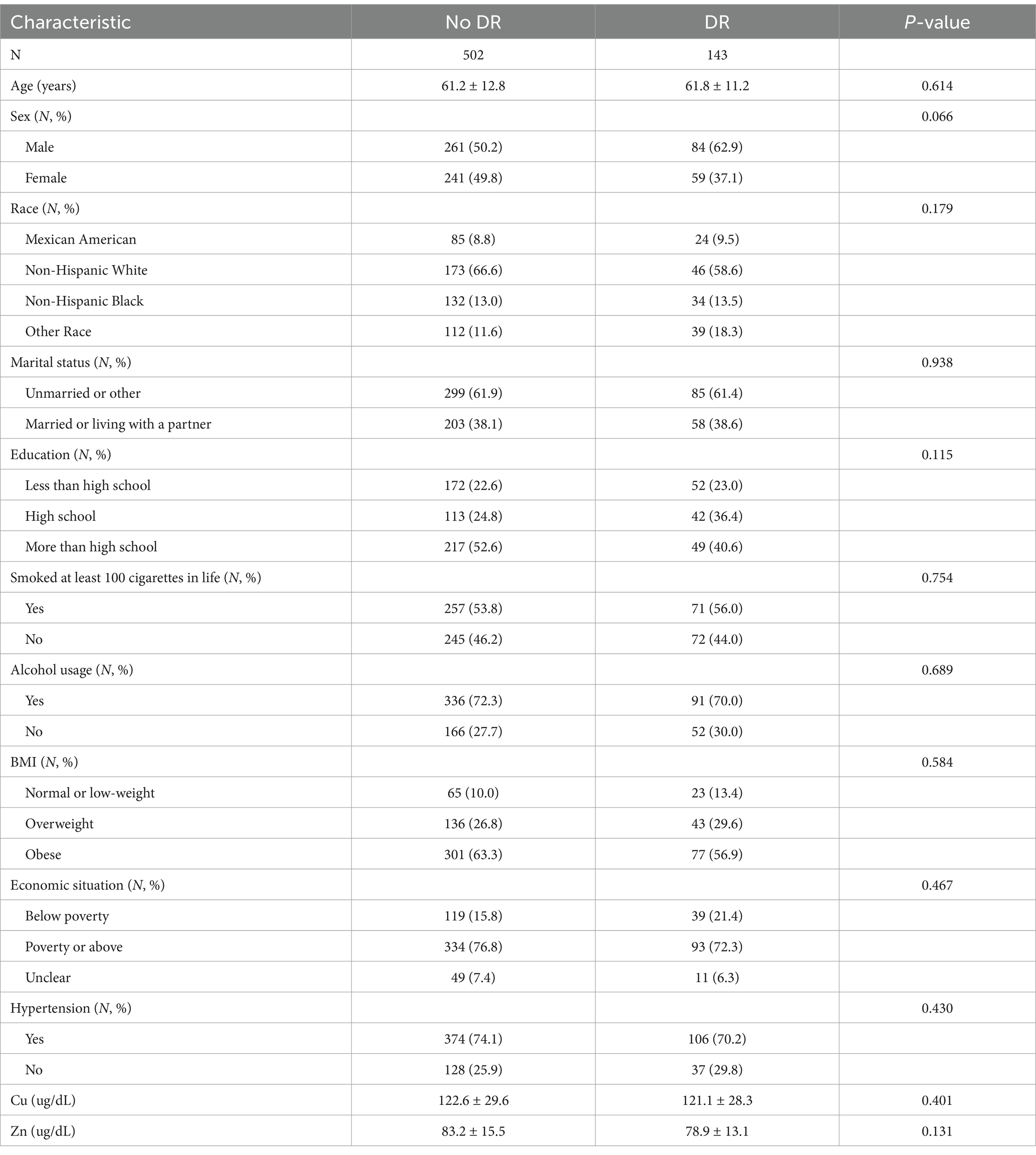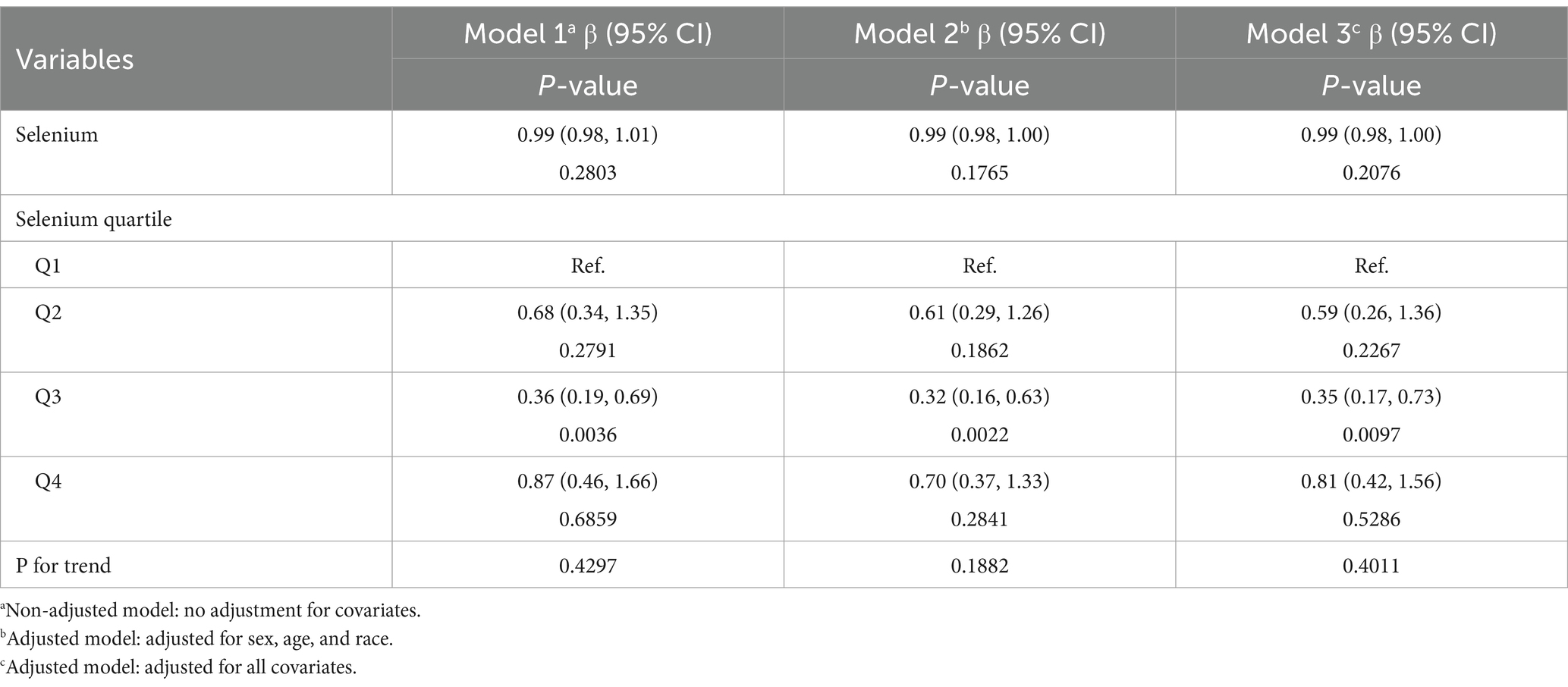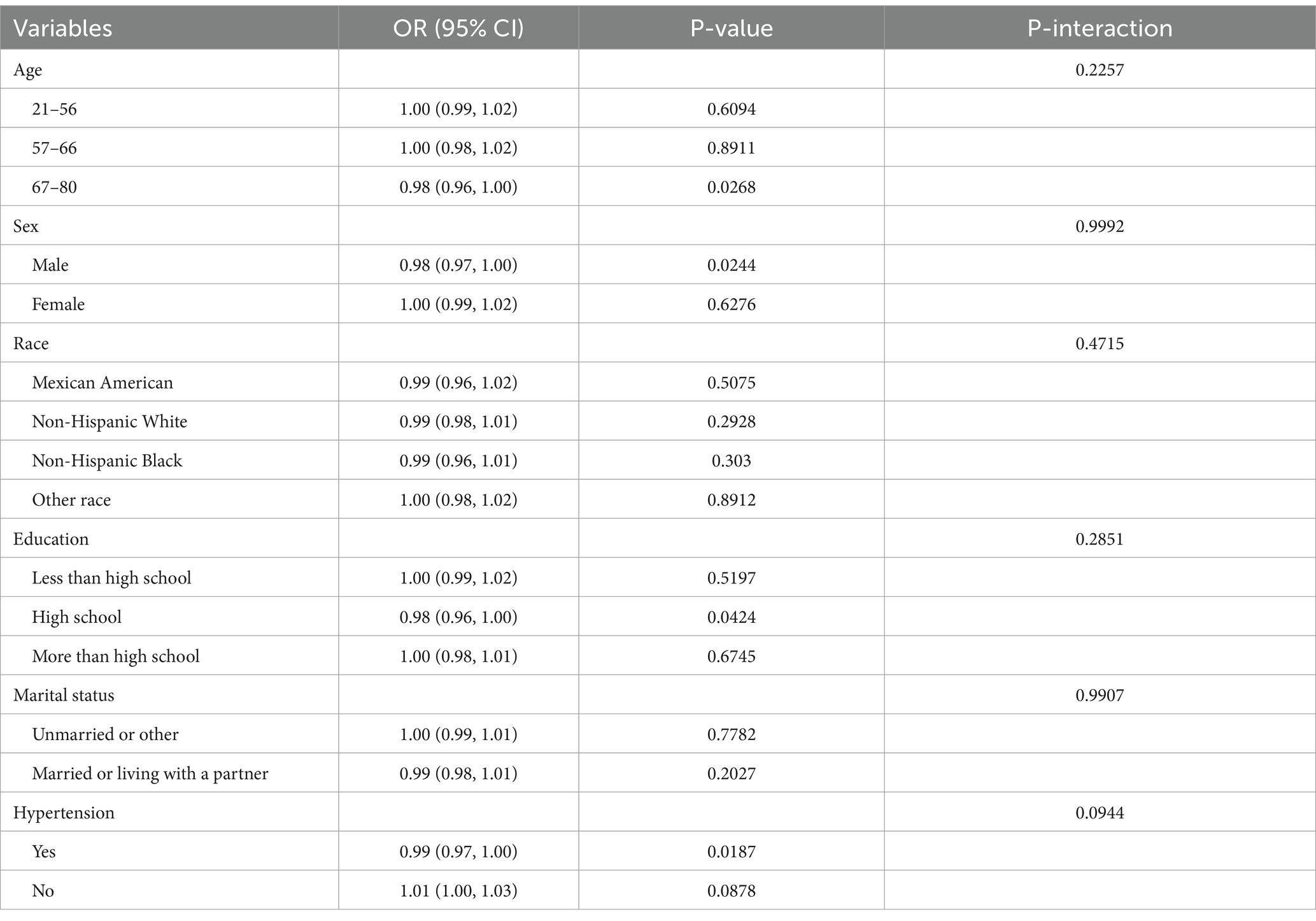- Eye Hospital, China Academy of Chinese Medical Sciences, Beijing, China
Background: Several studies have established a clear link between serum selenium levels and various health outcomes. However, to date, only a few studies have found an association between serum selenium levels and diabetic retinopathy (DR). The exact link between them is unclear. We collected data from different patient populations.
Methods: Data from 645 adults, collected through the National Health and Nutrition Examination Survey (NHANES) between 2011 and 2016, were analyzed. The association between serum selenium levels and the incidence of DR was assessed using binary logistic regression. Subgroup analysis, smoothed curve-fitting analysis, and propensity score weighting were used to investigate the association further.
Results: According to the multivariate analysis, there was no statistically significant linear association between serum selenium levels and the probability of developing DR (p > 0.05). Segmented regression analysis, however, showed that the chance of developing DR was considerably lower when selenium levels reached the threshold of 106.8 μg/L (OR = 0.88, p = 0.0107).
Conclusion: A U-shaped curve represents the link between serum selenium levels and DR. The incidence of DR is elevated in individuals with serum selenium levels that are either higher or lower than the optimal range.
1 Introduction
One of the most common microvascular complications that affect people with diabetes is diabetic retinopathy (DR) (1). Characterized mainly by retinal microangiopathy, diabetic retinopathy is a major cause of adult blindness worldwide (2). DR usually appears in those with poor glycemic control and a long history of diabetes. Statistics show that approximately 34.6% of individuals with diabetes worldwide are affected by DR, and approximately 10% of these patients experience severe forms of the condition, leading to significant vision impairment (3). Diabetes affects an estimated 537 million people worldwide in 2021. Diabetes prevalence continues to climb, with the population expected to reach 784 million by 2045 (4). The global burden of DR has grown significantly, with diabetes-related visual loss estimated to cost $500 million by 2050. It is therefore vital to combat DR. However, it is really tough (5).
Selenium is a key trace element found in many foods that is crucial for human health and has been demonstrated to reduce the incidence of certain cancers (6). After absorption, selenium is incorporated into several selenoproteins, which mediate its biological actions. Some of the biological actions of selenium, including promoting apoptosis, inhibiting vascular endothelial growth factor, neoangiogenesis, and matrix metalloproteinases, can hinder cancer spread by preventing tumor growth and metastasis. While selenium is essential for good health, an excessive intake can be detrimental. These effects can also be toxic to healthy tissues and disrupt normal cellular functions.
Some research indicates that minerals could aid in the prevention of DR (7). The development of DR is heavily influenced by oxidative stress and chronic inflammation caused by hyperglycemia. Selenium, an essential antioxidant trace element, has been shown to mitigate oxidative stress and inflammation by enhancing glutathione peroxidase activity (8). Consequently, both selenium deficiency and excess may exacerbate oxidative stress and inflammation, potentially compromising the health of retinal microvasculature (9). However, the connection between serum selenium levels and the prevalence of DR remains unclear. Some studies suggest that people with diabetes tend to have lower serum selenium levels than healthy individuals (10). In contrast, some studies have suggested that greater serum selenium levels are associated with an increased risk of developing type 2 diabetes (11, 12). This discrepancy could be attributed to the dual role of selenium in both regulating insulin signaling pathways and modulating oxidative stress (13).
In conclusion, whereas heavy metals have been linked to an increased risk of developing DR, the relationship between selenium and DR remains uncertain. The purpose of this study was to investigate the association between serum selenium levels and the prevalence of DR by analyzing data from the 2011–2016 NHANES. The findings may shed light on the potential role of selenium in preventing and managing DR.
2 Materials and methods
2.1 Study participants
The NHANES is a nationally representative transect survey. It can provide objective data about the population’s nutritional and health problems. The NHANES collects data through a multistage random sample. All participants were subjected to comprehensive measurements and completed standardized interview questionnaires. We analyzed NHANES data from 2011 to 2016. Of the 29,902 participants in NHANES 2011–2016, we excluded those with missing serum selenium screening data (N = 22,618) and no information on DR (N = 6,585). Furthermore, minor participants (n = 6) and those lacking complete data on other covariates (n = 48) were excluded. Finally, the final number of subjects included in the analysis was 645. Figure 1 depicts the participant selection process.
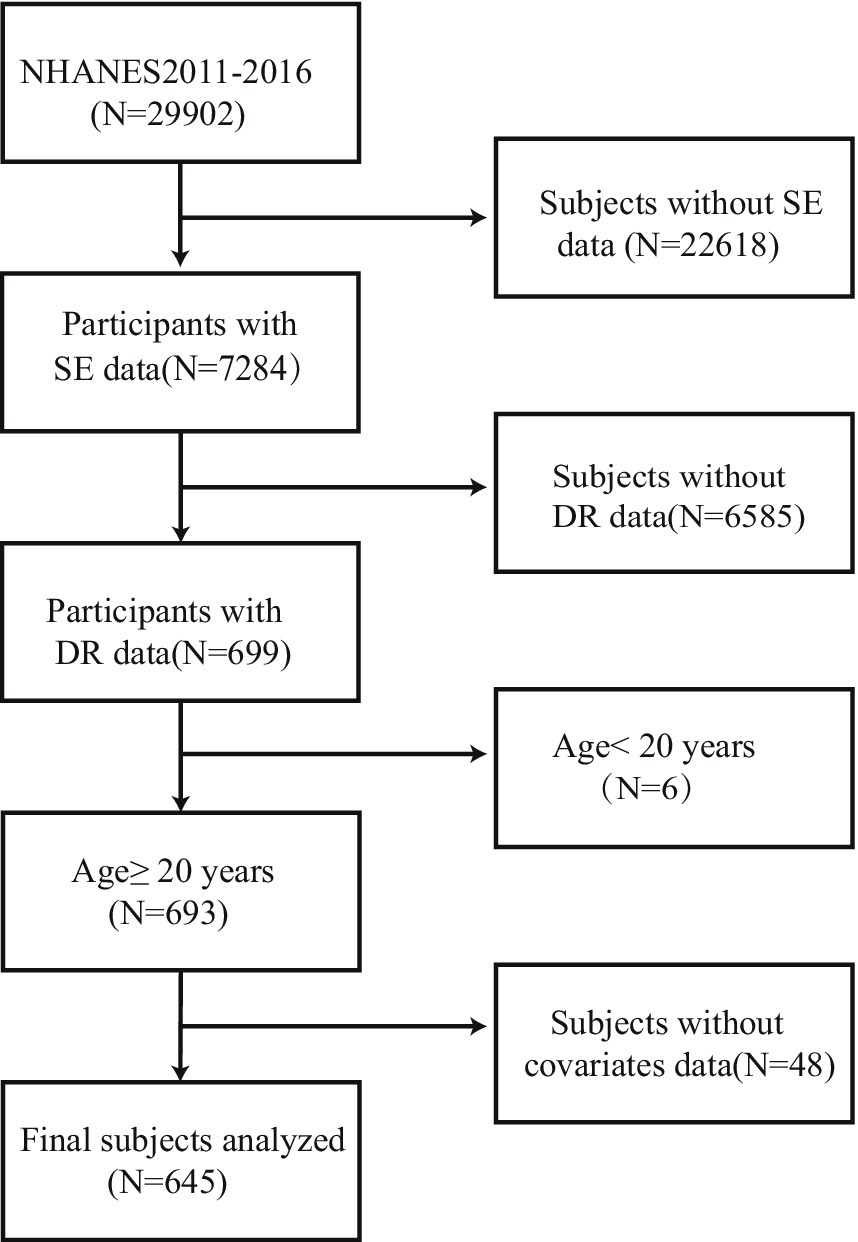
Figure 1. Diagrammatic representation of patient selection. NHANES, National Health and Nutrition Examination Survey. DR, diabetic retinopathy.
2.2 Diabetic retinopathy assessment
First, diabetes screening was performed, and then, screening for DR in the diabetic population was carried out. The diagnosis of diabetes among participants was established based on the fulfillment of any of the following conditions: (1) hemoglobin A1c (HbA1c) levels equal to or exceeding 6.5%; (2) fasting plasma glucose (FPG) concentrations of 7 mmol/L or higher; (3) a 2-h plasma glucose value of 11.1 mmol/L or greater during an oral glucose tolerance test; (4) self-reported information indicating a prior diagnosis of diabetes by a healthcare professional; and (5) ongoing treatment with insulin or other antidiabetic medications. DR was assessed using a two-point self-report question, where participants indicated whether a doctor had informed them that diabetes had been affecting their eyes (DIQ080). A “yes” response resulted in a DR diagnosis.
2.3 Determination of serum selenium
A physician performed venipuncture to collect serum samples, which were subsequently processed and analyzed at the Centers for Disease Control and Prevention (CDC) laboratory. The samples were cryopreserved. Following dilution, the blood samples were analyzed using ICP-DRC-MS. Samples must be homogenously mixed to avoid the formation of clots, which could otherwise affect the analytical results. The method is capable of performing highly sensitive multi-element analyses. The method ensures the accurate determination of trace elements, including zinc, copper, and selenium. All results were above the acceptable lower limit of detection.
2.4 Covariate assessment
Demographic data, such as sex, age, race, marital status, education level, and economic status, were included. BMI was divided into three distinct groups: normal or underweight (less than 25.0 kg/m2), overweight (between 25.0 and 29.9 kg/m2), and obese (30.0 kg/m2 or higher). Lifestyle factors were assessed using a self-report questionnaire. Participants were classed as either non-drinkers or drinkers based on their self-reported consumption of more than 12 alcoholic beverages over the course of their lifetime. Smokers were divided into two groups: never smokers and smokers, based on whether they had smoked fewer than 100 cigarettes in their lifetime. Participants were considered to have high blood pressure if a doctor had informed them of the condition, if they were taking blood pressure medication, or if their blood pressure was higher than normal.
2.5 Statistical analysis
To achieve the desired results, we employed both weighted and variance estimation methods. Weighted multivariate logistic regression models were employed. Continuous variables were assessed using independent t-tests, and categorical variables were evaluated with the chi-square tests. Logistic regression models were employed to examine the relationship between serum selenium levels and DR. Subgroup analyses were conducted using covariates, and further subgroup analyses were performed using stratified multiple regression analysis. Differences across subgroups were investigated, as well as potential interaction effects. All analyses were conducted using R (version 4.1.1) and EmpowerStats (version 4.2). All analyses were performed using regression models, with a significance threshold set at a p-value of 0.05, where p-values of 0.05 or lower were considered statistically significant.
3 Results
3.1 Study population characteristics
As shown in Table 1, the study divided participants into two groups according to whether they had DR or not. In the analysis of factors associated with DR, the study found that all variables did not show statistically significant differences.
3.2 Association between serum selenium and DR
The regression analysis provided in Table 2 revealed that there was no statistically significant overall association between serum selenium levels and DR (p > 0.05). However, patients with selenium levels in the third quartile (Q3) exhibited a significantly reduced risk of DR (p < 0.01). The effect of extremely low (Q1, Q2) or high (Q4) selenium levels was not statistically significant. The trend tests indicated that there was no statistically significant linear relationship between selenium levels and the risk of developing DR. This indicates that selenium may exert a protective effect at moderate levels, potentially exhibiting a ‘U-shaped’ relationship.
3.3 Identification of non-linear relationship
As illustrated by the smoothed curve fit in Figure 2 and the segmented regression analysis in Table 3, serum selenium levels exhibited a U-shaped relationship with the risk of DR. A one-unit increase in selenium levels significantly reduced the risk of DR when selenium levels were below the threshold of 106.8 μg/L (OR = 0.88, p = 0.0107). Conversely, changes in selenium level above the turning point were observed to have no significant effect on the risk of DR (OR = 1.00, p = 0.5630). A linear log-likelihood ratio test (LRT, p = 0.009) provided further support for the superiority of the segmented model over the unilinear model, indicating that selenium may play a more significant protective role at lower levels.
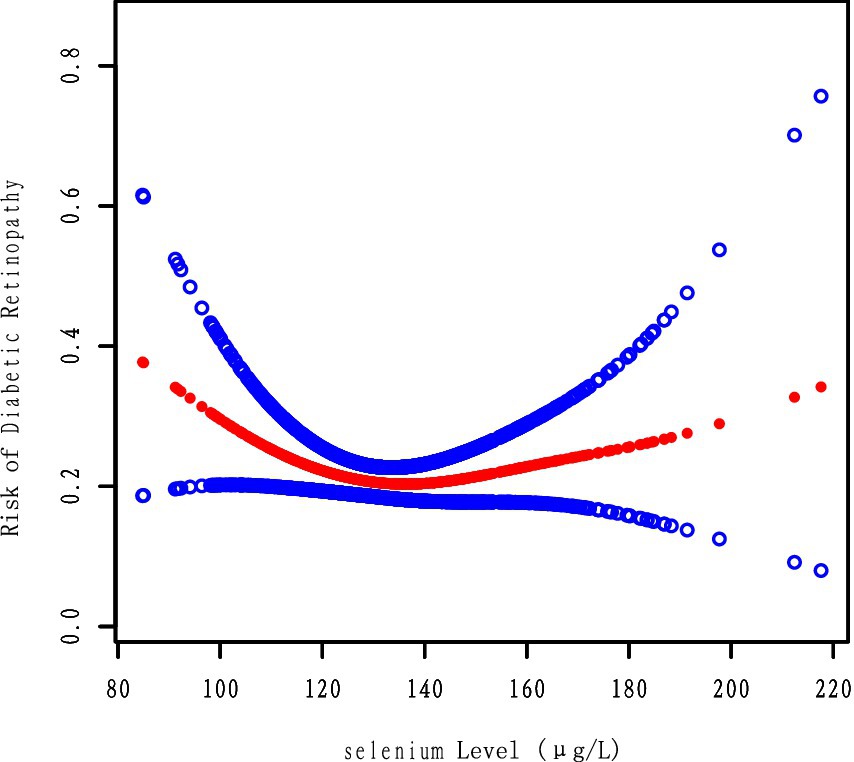
Figure 2. Smooth curve fitting analysis demonstrates the association between SE and the prevalence of DR.
3.4 Subgroup analyses
As demonstrated in the stratified analysis presented in Table 4, the risk of DR was associated with age, gender, education level, and hypertension. The risk of DR was observed to be slightly lower in the older age group of 67–80 years (p = 0.0268), men (p = 0.0244), those with a high school education (p = 0.0424), and hypertension (p = 0.0187). No significant associations were found between race and marital status, and none of the interaction effects between these variables were statistically significant. This suggests that the independent effects of these factors on DR risk are limited.
4 Discussion
This study presents the first evidence linking selenium levels to the risk of DR. Moreover, by controlling for confounders did not change the association between selenium levels and DR. Studies have shown a U-shaped correlation between serum selenium levels and overall DR risk. The results of the segmented regression analysis indicated that the risk of DR was significantly reduced when selenium levels were at the tipping point of 106.8 (OR = 0.88, p = 0.0107). These findings indicate that maintaining selenium levels approximately 106.8 μg/L may confer a protective effect. The combined effect of selenium was found to exhibit a ‘U-shaped’ characteristic when analyzed using a smoothed curve-fitting technique. Our findings indicated that higher serum selenium levels were associated with an increased risk of DR. Existing studies do find that excessive levels of selenium may increase the risk of DR (14). In addition, zinc levels were significantly lower in the DR group than in the control group (p = 0.003). These results further support the hypothesis that micronutrients may influence the development of DR.
Studies have analyzed the association between serum heavy metals (e.g., manganese, lead, and cadmium) and DR (15). Manganese was found to be significantly negatively correlated with DR. Nevertheless, no notable correlation was observed between heavy metals, including selenium, and the occurrence of DR. In contrast, the present study focused on the trace element selenium (14). We found a strong correlation between serum selenium levels and the risk of developing DR. The reason for this discrepancy may be the lack of serum selenium data for 2017–2020 in the NHANES database. Moreover, the scope of their study is 2011–2020. The treatment of missing data in their study may have contributed to the results. We excluded populations with missing serum selenium data. This makes our results relatively more reliable, despite the differences in analytical methodology and research focus between the two studies. However, both studies highlighted the potential involvement of trace elements in the pathogenesis of DR. One study has shown that heavy metals are associated with the risk of DR. However, this study did not include selenium (16). Our study investigated the relationship between serum selenium and DR. Another study showed that selenium can reduce oxidative damage (17). This has implications for the prevention and treatment of DR. Other clinical studies have found that selenium does have an effect on the development of DR (18, 19). However, their study did not look at the effect of specific levels of selenium in combating DR. Our findings indicated that selenium levels below the tipping point were associated with a significantly lower risk of DR. The data revealed a U-shaped association between selenium levels and DR. In addition, a potential risk factor for DR was identified as zinc deficiency. This result is consistent with existing studies (20, 21). Existing studies have found that zinc improves diabetic cataracts by modulating lens protein and polyol pathways (22). However, it is not yet known exactly how to improve DR. It is recommended that future studies should further investigate the specific roles and mechanisms of these elements in the prevention and treatment of DR (23).
Selenium affects DR through several mechanisms. First, selenium is an important component of selenoproteins, such as glutathione peroxidase and catalase. They play a key role in neutralizing reactive oxygen species and reducing oxidative stress (24). Oxidative stress is an important cause of DR pathogenesis. By enhancing the activity of these antioxidant enzymes, selenium helps reduce oxidative stress and attenuates retinal cell damage (25). Second, diabetes causes the body to be in a chronic low-grade inflammatory state for a long time. It increases the incidence of DR. Selenium modulates the inflammatory response by reducing the production of pro-inflammatory cytokines and tumor necrosis factor-α (TNF-α) (26). This helps reduce inflammatory damage to retinal microvessels and neural tissue. Third, selenium has been shown to enhance vascular endothelial cell function by reducing endothelial dysfunction (27). This reduces vascular leakage and neovascularization, thereby protecting the retinal vasculature to better protect visual function. Fourth, emerging evidence suggests that selenium may play a role in glucose metabolism and insulin signaling. Hyperglycemia is a major cause of DR. By improving insulin sensitivity and reducing hyperglycemia, selenium may indirectly reduce the risk of DR onset and progression (28, 29). Fifth, retinal fibrosis is a late complication of DR that can lead to vision loss (30). Selenium has been shown to inhibit the activation of transforming growth factor-β (TGF-β) and reduce the deposition of extracellular matrix components such as collagen and fibronectin (31). By blocking retinal fibrosis, selenium may be able to reduce fibrosis in the retina and may play a role in slowing the advancement of DR. Finally, recent studies have identified a potential role for selenium in epigenetic modifications, such as DNA methylation and histone acetylation. This may affect the expression of genes involved in oxidative stress, inflammation, and angiogenesis (32). These epigenetic effects may further contribute to the protective effects of selenium against DR. In conclusion, selenium has multifaceted mechanisms for the prevention and treatment of DR. Further studies are needed to fully elucidate these mechanisms in the future and explore the potential for selenium intervention in clinical settings.
However, it is important to acknowledge several limitations in this study. First, the cross-sectional design prevents establishing a causal link between blood selenium levels and the development of DR. Second, the absence of longitudinal data precludes the determination of changes in selenium levels over time and their potential correlation with the progression of DR. It is recommended that future studies should incorporate longitudinal data to further validate the causal relationship between selenium levels and DR. Third, the outcome measures relied on self-reported histories of DR, which may not be entirely reliable. Fourth, the study sample was limited due to the substantial amount of missing data on DR and selenium in the NHANES database. Future studies with larger sample sizes are still needed to validate our findings. Finally, the study took into account as many confounding factors as possible. However, there are still unmeasured variables that may affect the results. We hope that future studies will collect relevant data (e.g., diet and lifestyle) more comprehensively to reduce bias.
5 Conclusion
In conclusion, the results of this study reveal a U-shaped association between serum selenium levels and DR, suggesting that selenium supplementation should be balanced to avoid excessive intake. Moderate selenium consumption has shown potential benefits in preventing DR. In addition, the findings highlight the possible role of both serum selenium and zinc in DR prevention. Future longitudinal studies are needed to better understand the underlying mechanisms of the effects of selenium, which could help develop personalized prevention and intervention strategies for DR.
Data availability statement
The raw data supporting the conclusions of this article will be made available by the authors, without undue reservation.
Ethics statement
The studies involving humans were approved by the Institutional Review Board of the National Center for Health Statistics. The studies were conducted in accordance with the local legislation and institutional requirements. Written informed consent for participation was not required from the participants or the participants’ legal guardians/next of kin in accordance with the national legislation and institutional requirements.
Author contributions
XC: Conceptualization, Methodology, Writing – original draft, Writing – review & editing. MS: Data curation, Methodology, Writing – original draft. ZG: Writing – original draft. XH: Methodology, Supervision, Writing – review & editing. LX: Funding acquisition, Supervision, Validation, Writing – review & editing.
Funding
The author(s) declare that financial support was received for the research and/or publication of this article. This study was funded by the project to establish a High-Level Chinese Medicine Hospital at the Eye Hospital of the China Academy of Traditional Chinese Medicine (Grant No. GSP4-02-2, Grant No. GSP4-02-3), the Major Research Project of Science and Technology Innovation Project of China Academy of Traditional Chinese Medicine (Grant No. CI2021A05107), the Capital Health Development Scientific Research Specialised Key Projects (Grant No. 2020-1-4181).
Acknowledgments
I would like to extend my heartfelt gratitude to all the members of our research team for their invaluable contributions, dedication, and collaborative spirit throughout this project. In addition, I am deeply grateful to the National Health and Nutrition Examination Survey (NHANES) database for providing the comprehensive and high-quality data that formed the foundation of this research.
Conflict of interest
The authors declare that the research was conducted in the absence of any commercial or financial relationships that could be construed as a potential conflict of interest.
Generative AI statement
The authors declare that no Gen AI was used in the creation of this manuscript.
Publisher’s note
All claims expressed in this article are solely those of the authors and do not necessarily represent those of their affiliated organizations, or those of the publisher, the editors and the reviewers. Any product that may be evaluated in this article, or claim that may be made by its manufacturer, is not guaranteed or endorsed by the publisher.
References
1. Evans, MA, Saint-Aubin, J, and Landry, N. Letter names and alphabet book reading by senior kindergarteners: an eye movement study. Child Dev. (2009) 80:1824–41. doi: 10.1111/j.1467-8624.2009.01370.x
2. Heng, L, Comyn, O, Pető, T, Tadros, C, Ng, E, Sivaprasad, S, et al. Diabetic retinopathy: pathogenesis, clinical grading, management and future developments. Diabet Med. (2013) 30:640–50. doi: 10.1111/dme.12089
3. Wang, LZ, Cheung, CY, Tapp, RJ, Hamzah, H, Tan, G, Ting, D, et al. Availability and variability in guidelines on diabetic retinopathy screening in Asian countries. Br J Ophthalmol. (2017) 101:1352–60. doi: 10.1136/bjophthalmol-2016-310002
4. Ogurtsova, K, da Rocha Fernandes, JD, Huang, Y, Linnenkamp, U, Guariguata, L, Cho, NH, et al. IDF diabetes atlas: global estimates for the prevalence of diabetes for 2015 and 2040. Diabetes Res Clin Pract. (2017) 128:40–50. doi: 10.1016/j.diabres.2017.03.024
5. Le, NT, Kroeger, ZA, Lin, WV, Khanani, AM, and Weng, CY. Novel treatments for diabetic macular edema and proliferative diabetic retinopathy. Curr Diab Rep. (2021) 21:43. doi: 10.1007/s11892-021-01412-5
6. Heidari, Z, Sepehri, Z, and Doostdar, A. Serum selenium status in patients with type 2 diabetes and control group. Global J Health Sci. (2016) 9:234. doi: 10.5539/gjhs.v9n5p234
7. Li, YQ, Zhang, ST, Ke, NY, Fang, YC, Hu, WL, Li, GA, et al. The impact of multiple metals exposure on the risk of developing proliferative diabetic retinopathy in Anhui, China: a case-control study. Environ Sci Pollut Res Int. (2023) 30:112132–43. doi: 10.1007/s11356-023-30294-1
8. Bajpai, S, Mishra, M, Kumar, H, Tripathi, K, Singh, S, Pandey, H, et al. Effect of selenium on connexin expression, angiogenesis, and antioxidant status in diabetic wound healing. Biol Trace Elem Res. (2011) 144:327–38. doi: 10.1007/s12011-011-9097-7
9. Zou, C, Qiu, Q, Chen, H, Liu, D, and Liang, J. Hepatoprotective effects of selenium during diabetes in rats. Hum Exp Toxicol. (2015) 35:114–23. doi: 10.1177/0960327115579207
10. Faghihi, T, Radfar, M, Barmal, M, Amini, P, Qorbani, M, Abdollahi, M, et al. A randomized, placebo-controlled trial of selenium supplementation in patients with type 2 diabetes. Am J Ther. (2014) 21:491–5. doi: 10.1097/mjt.0b013e318269175f
11. Feng, W, Cui, X, Liu, B, Liu, C, Xiao, Y, Lü, W, et al. Association of urinary metal profiles with altered glucose levels and diabetes risk: a population-based study in China. PLoS One. (2015) 10:e0123742. doi: 10.1371/journal.pone.0123742
12. Lu, C, Chang, H, Yang, K, Kuo, C, Lee, L, and Huang, K. High serum selenium levels are associated with increased risk for diabetes mellitus independent of central obesity and insulin resistance. BMJ Open Diabetes Res Care. (2016) 4:e000253. doi: 10.1136/bmjdrc-2016-000253
13. Wang, X, Yang, T, Wei, J, Lei, G, and Zeng, C. Association between serum selenium level and type 2 diabetes mellitus: a non-linear dose–response meta-analysis of observational studies. Nutr J. (2015) 15:48. doi: 10.1186/s12937-016-0169-6
14. Wang, C, Ran, R, Jin, X, and Zhu, X. Plasma and vitreous selenium concentrations in patients with type 2 diabetes and diabetic retinopathy. Medicine. (2022) 101:e30877. doi: 10.1097/MD.0000000000030877
15. Zhang, Y, Liu, X, Zhang, X, Li, L, Li, Q, Geng, H, et al. Association between serum heavy metal levels and diabetic retinopathy in NHANES 2011-2020. Sci Rep. (2024) 14:1268. doi: 10.1038/s41598-024-51749-6
16. Gui, Y, Gui, S, Wang, X, Li, Y, Xu, Y, and Zhang, J. Exploring the relationship between heavy metals and diabetic retinopathy: a machine learning modeling approach. Sci Rep. (2024) 14:13049. doi: 10.1038/s41598-024-63916-w
17. Bryl, A, Mrugacz, M, Falkowski, M, and Zorena, K. The effect of diet and lifestyle on the course of diabetic retinopathy-a review of the literature. Nutrients. (2022) 14:1252. doi: 10.3390/nu14061252
18. Wróblewska, J, Nuszkiewicz, J, Wróblewski, M, Wróblewska, W, and Woźniak, A. Selected trace elements and their impact on redox homeostasis in eye health. Biomol Ther. (2024) 14:1356. doi: 10.3390/biom14111356
19. Öztürk Kurt, HP, Karagöz Özen, DS, İpek, G, Erdem, M, and Demirdağ, MD. Comparison of selenium levels between diabetic patients with and without retinopathy: selenium levels and diabetic retinopathy. J Surg Med [Internet]. (2023) 7:58–62. doi: 10.28982/josam.7673
20. Naghizadeh, S, Kheirouri, S, Ojaghi, H, and Jafari, KA. Zinc supplementation attenuate diabetic indices in patients with diabetic retinopathy. Progr Nutr. (2018) 20:263–9. doi: 10.23751/pn.v20i2-S.5572
21. Mehta, N, Akram, M, and Singh, YP. The impact of zinc supplementation on hyperglycemia and complications of type 2 diabetes mellitus. Cureus. (2024) 16:e73473. doi: 10.7759/cureus.73473
22. Barman, S, and Srinivasan, K. Zinc supplementation ameliorates diabetic cataract through modulation of Crystallin proteins and polyol pathway in experimental rats. Biol Trace Elem Res. (2019) 187:212–23. doi: 10.1007/s12011-018-1373-3
23. Beloucif, A, Kechrid, Z, and Bekada, A. Effect of zinc deficiency on blood glucose, lipid profile, and antioxidant status in streptozotocin diabetic rats and the potential role of sesame oil. Biol Trace Elem Res. (2021) 200:3236–47. doi: 10.1007/s12011-021-02934-5
24. Agbor, GA, Vinson, JA, Patel, S, Patel, K, Scarpati, J, Shiner, D, et al. Effect of selenium-and glutathione-enriched yeast supplementation on a combined atherosclerosis and diabetes hamster model. J Agric Food Chem. (2007) 55:8731–6. doi: 10.1021/jf0711901
25. Dludla, P, Ziqubu, K, Mabhida, S, Mazibuko-Mbeje, S, Hanser, S, Nkambule, B, et al. Dietary supplements potentially target plasma glutathione levels to improve cardiometabolic health in patients with diabetes mellitus: a systematic review of randomized clinical trials. Nutrients. (2023) 15:944. doi: 10.3390/nu15040944
26. He, D, Wu, H, Jiang, H, Zhang, Z, Wang, C, Wang, D, et al. Screening of selenium/glutathione-enriched Candida utilis and its anti-inflammatory and antioxidant activities in mice. Biol Trace Elem Res. (2024) 202:2786–96. doi: 10.1007/s12011-023-03882-y
27. Gouaref, I, Otmane, A, Makrelouf, M, Abderrhmane, SA, Haddam, AEM, and Koceir, EA. Crucial interactions between altered plasma trace elements and fatty acids unbalance ratio to Management of Systemic Arterial Hypertension in diabetic patients: focus on endothelial dysfunction. Int J Mol Sci. (2024) 25:9288. doi: 10.3390/ijms25179288
28. Jingi, A, Tankeu, A, Ateba, N, and Noubiap, J. Mechanism of worsening diabetic retinopathy with rapid lowering of blood glucose: the synergistic hypothesis. BMC Endocr Disord. (2017) 17:63. doi: 10.1186/s12902-017-0213-3
29. Nyakaba, T. Risk factors associated with diabetic retinopathy among patients aged 50-75 years attending diabetic clinic at mbagathi hospital Nairobi county, Kenya. Int J Trop Dis Health. (2023) 44:18–26. doi: 10.9734/ijtdh/2023/v44i151459
30. Ji, Z, Lin, S, Gui, S, Gao, J, Cao, F, Guan, Y, et al. Overexpressed Poldip 2 incurs retinal fibrosis via the TGF-β1/SMAD3 signaling pathway in diabetic retinopathy. Diabetes. (2024) 73:1742–55. doi: 10.2337/db23-1036
31. Xiao, X, Huang, G, Yu, X, and Tan, Y. Advances in selenium and related compounds inhibiting multi-organ fibrosis. Drug Des Devel Ther. (2025) 19:251–65. doi: 10.2147/DDDT.S488226
Keywords: selenium, diabetic retinopathy, NHANES, epidemiology, cross-sectional study
Citation: Chen X, Sun M, Gu Z, Hao X and Xie L (2025) Association of serum selenium levels with diabetic retinopathy: NHANES 2011–2016. Front. Med. 12:1546214. doi: 10.3389/fmed.2025.1546214
Edited by:
Martina Tomić, Merkur University Hospital, CroatiaReviewed by:
Susmita Barman, University of Nebraska Medical Center, United StatesOscar Abel Sánchez-Velázquez, University of Leeds, United Kingdom
Copyright © 2025 Chen, Sun, Gu, Hao and Xie. This is an open-access article distributed under the terms of the Creative Commons Attribution License (CC BY). The use, distribution or reproduction in other forums is permitted, provided the original author(s) and the copyright owner(s) are credited and that the original publication in this journal is cited, in accordance with accepted academic practice. No use, distribution or reproduction is permitted which does not comply with these terms.
*Correspondence: Xiaofeng Hao, Zm1tdWhhb0AxNjMuY29t; Like Xie, Ymp4aWVsaWtlQHNpbmEuY29t
†These authors have contributed equally to this work
 Xi Chen
Xi Chen Mei Sun†
Mei Sun† Zhenzhen Gu
Zhenzhen Gu